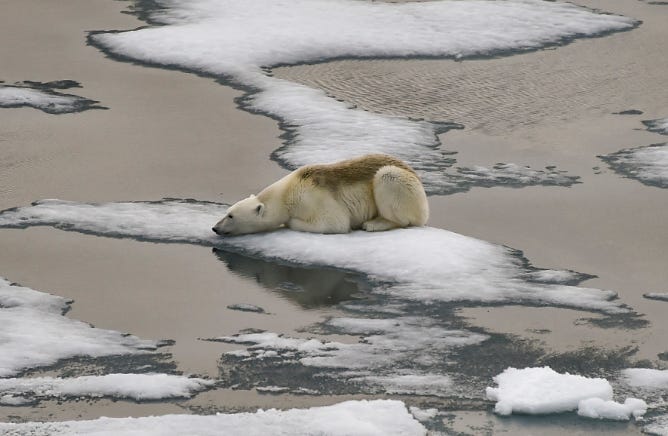Overwhelmed by climate change? Welcome to Greenprint - the place where we try to simplify all things climate and share musings on tackling our warming world.
If you haven’t subscribed, please consider joining (for free!):
Climate news often features a tornado of buzzwords, emerging technologies, and seemingly important numbers, as well as the occasional polar bear photos.

But where does it all fit in?
In this piece, I detail a 4-step approach to thinking about climate. Everything you see and hear about climate will fit somewhere within these 4 realms.
I’m a big believer in structure and mental models. They help us see the bigger picture and understand how each topic fits into the overall narrative of climate action. Whether it’s diving into the science, exploring sustainable practices, or spotlighting innovative solutions, everything should have its place.
As I write more, I will be coming back and updating this page with links.
1. I'm new around here. What is climate change?
1.1 Greenhouse gases are atmospheric gases (e.g., carbon dioxide) that trap a portion of heat rather than radiating it into space
1.2 Due to human activity, greenhouse gases have increased dramatically in the last few centuries
1.3 The result? Global warming. We're living on a planet that is the warmest it has ever been. Global warming then leads to climate change, which is a change in a region's average conditions (e.g., temperature) over a long period of time.
1.4 Climate change can lead to physical risks (more frequent and severe adverse natural events) and transition risks (changes made in response to climate change issues)
2. Ok, that doesn't sound great. What do we need to aim for?
2.1 As part of the Paris Agreement, 195 countries committed to keeping the rise in global surface temperature to well below 2 °C (3.6 °F), and preferably 1.5 °C (2.7 °F) above pre-industrial levels (i.e., 1850-1900). Today, the world is around 1.1 °C (2.0 °F) above pre-industrial levels.
2.2 As temperatures increase, the physical effects of climate change become exponentially larger. As we get further above the 1.5 °C (2.7 °F) mark, more and more "feedback loops" come into play.
2.3 In order to meet the 1.5°C (2.7 °F) global warming target in the Paris Agreement, global carbon emissions should reach net zero around 2050. 'Net zero' means that any emissions are balanced by absorbing an equivalent amount from the atmosphere.
3. How do we get to net zero?
The atmosphere is like an overfilled bath. To reduce the water level we need to 'close the tap' (reduce annual emissions) and we need to 'remove the plug' (remove accumulated carbon from the atmosphere).
3.1 We can’t (and don’t need to) close the natural emissions tap. Natural emissions, such as ocean release and volcanic venting, have been around for millions of years.
3.2 To close the human-made emissions tap, we need to do the following:
Decarbonize power - build renewables and storage, reduce demand, upgrade grid
Electrify everything - electrify transport (e.g., EV), buildings (e.g., heat pumps), industry (e.g., green hydrogen)
Fix agriculture - minimize inputs, invest in sustainable agri
3.3 To remove the plug, we need to preserve natural land and ocean carbon sinks …
3.4 … as well as:
Test and expand engineered carbon capture
Test and expand nature-based carbon capture
Set up carbon markets to incentivize carbon capture
3.5 Climate change is real, and it’s happening now. Even if we cut emissions today, some level of warming (and the floods, heatwaves, and storms that come with it) is already locked in. Adaptation is about preparing for the climate impacts we can no longer avoid.
4. This sounds like a lot to do. Who is helping us on this?
4.1 Consumers (aka you!) - Consumers hold some serious power in the fight against climate change, and it all starts with the choices we make every day. Whether it be buying electric vehicles (or even better, taking public transport), reducing waste, installing solar panels, or advocating for stronger climate policies, we can force organizations and governments to take climate change seriously.
4.2 Organizations - Organizations aren’t just cogs in the machine; they’re the big players that can drive the change we need. By going green, building/investing in sustainable tech, and aiming for net zero, they can shrink their carbon footprints and inspire entire industries to follow suit.
4.3 Governments - When it comes to tackling climate change, governments are the ones calling the shots. With the right mix of laws, carbon pricing, and renewable energy incentives, they can steer the ship (hopefully a zero-emission one!) toward a greener future.
In summary, climate change doesn't have to be overwhelming. In fact, it really boils down to 4 main questions:
What is climate change?
What are we aiming for?
How do we reach this aim?
What will enable us to reach this aim?
Yes, I have simplified this. A lot. But I hope this untangles some of the messiness.











